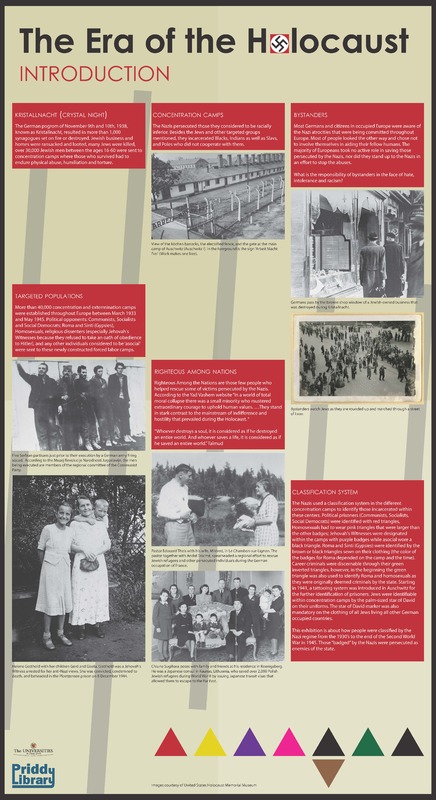Introduction 2
KRISTALLNACHT (CRYSTAL NIGHT)
The German pogrom of November 9th and 10th, 1938,
known as Kristallnacht, resulted in more than 1,000
synagogues set on fire or destroyed. Jewish business and
homes were ransacked and looted, many Jews were killed,
over 30,000 Jewish men between the ages 16-60 were sent to
concentration camps where those who survived had to
endure physical abuse, humiliation and torture.
CONCENTRATION CAMPS
The Nazis persecuted those they considered to be racially
inferior. Besides the Jews and other targeted groups
mentioned, they incarcerated Blacks, Indians as well as Slavs,
and Poles who did not cooperate with them.
BYSTANDERS
Most Germans and citizens in occupied Europe were aware of
the Nazi atrocities that were being committed throughout
Europe. Most of people looked the other way and chose not
to involve themselves in aiding their fellow humans. The
majority of Europeans took no active role in saving those
persecuted by the Nazis, nor did they stand up to the Nazis in
an effort to stop the abuses.
What is the responsibility of bystanders in the face of hate,
intolerance and racism?
TARGETED POPULATIONS
More than 40,000 concentration and extermination camps
were established throughout Europe between March 1933
and May 1945. Political opponents: Communists, Socialists
and Social Democrats; Roma and Sinti (Gypsies),
Homosexuals, religious dissenters (especially Jehovah's
Witnesses because they refused to take an oath of obedience
to Hitler), and any other individuals considered to be ‘asocial’
were sent to these newly constructed forced labor camps.
RIGHTEOUS AMONG NATIONS
Righteous Among the Nations are those few people who
helped rescue some of victims persecuted by the Nazis.
According to the Yad Vashem website “In a world of total
moral collapse there was a small minority who mustered
extraordinary courage to uphold human values. …They stand
in stark contrast to the mainstream of indifference and
hostility that prevailed during the Holocaust. “
“Whoever destroys a soul, it is considered as if he destroyed
an entire world. And whoever saves a life, it is considered as if
he saved an entire world.” Talmud
CLASSIFICATION SYSTEM
The Nazis used a classication system in the different
concentration camps to identify those incarcerated within
these centers. Political prisoners (Communists, Socialists,
Social Democrats) were identified with red triangles,
Homosexuals had to wear pink triangles that were larger than
the other badges; Jehovah's Witnesses were designated
within the camps with purple badges while asocial wore a
black triangle. Roma and Sinti (Gypsies) were identied by the
brown or black triangles sewn on their clothing (the color of
the badges for Roma depended on the camp and the time).
Career criminals were discernable through their green
inverted triangles, however, in the beginning the green
triangle was also used to identify Roma and homosexuals as
they were originally deemed criminals by the state. Starting
in 1941, a tattooing system was introduced in Auschwitz for
the further identication of prisoners. Jews were identifiable
within concentration camps by the palm-sized star of David
on their uniforms. The star of David marker was also
mandatory on the clothing of all Jews living all other German
occupied countries.
This exhibition is about how people were classified by the
Nazi regime from the 1930’s to the end of the Second World
War in 1945. Those “badged” by the Nazis were persecuted as
enemies of the state.
